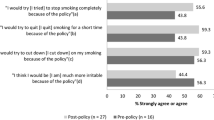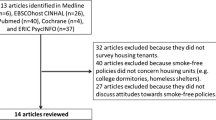Abstract
In 2010, Waterloo Region Housing (Canada) enacted a smoke-free (SF) housing policy that made all new leases in their community-housing portfolio (2722 units) 100 % SF. Existing lease holders were ‘grandfathered’—meaning tenants could still smoke in their homes. A survey to measure support for the policy and how the policy had impacted smoking behaviour was delivered to all 2722 households in the Waterloo Region Housing portfolio in 2010 (pre-policy), 2011 and 2013 (post-policy). The proportion of households that completed the survey was 26 % (n = 717) in 2010, 25 % (n = 685) in 2011, and 23 % (n = 619) in 2013. Support for the SF housing policy was 72 % pre-enactment (2010), and increased to 78 % in 2011 and 79 % in 2013; however, most smokers do not support the policy. In 2010, prior to the SF policy, 65 % of tenants who smoke reported someone smoked inside their home; in 2013 this was reduced to approximately half of smokers (52 %). In 2013, 44 % of smokers reported smoking outside more often than before the SF policy was enacted, almost half of tenants with a smoke-free lease (46 %) and more than a third of tenants who have a grandfathered lease (34 %) reported they smoke less since the smoke-free policy. There has been no significant change in the proportion of respondents (>50 %) who reported being exposed to second-hand smoke in their home. This SF housing policy is associated with increased reported outdoor smoking and reduced smoking. Smoke-free policies may support smokers interested in quitting.
Similar content being viewed by others
References
Statistics Canada. (2012). Health at a glance: Current smoking trends. Statistics Canada Catalogue no. 82-624-X Web site. Retrieved from http://www.statcan.gc.ca/pub/82-624-x/2012001/article/11676-eng.htm. Updated 19 June 2012.
Reid, J., Hammond, D., Rynard, V., & Burkhalter, R. (2015). Tobacco use in Canada: Patterns and trends (2015th ed.). Waterloo, ON: Propel Centre for Population Health Impact, University of Waterloo.
Reid, J. L., Hammond, D., Boudreau, C., Fong, G. T., & Siahpush, M. (2010). Socioeconomic disparities in quit intentions, quit attempts, and smoking abstinence among smokers in four western countries: Findings from the International Tobacco Control Four Country Survey. Nicotine and Tobacco Research, 12(Suppl), S20–S33. doi:10.1093/ntr/ntq051.
Reid, J. L., Hammond, D., & Driezen, P. (2010). Socio-economic status and smoking in Canada, 1999–2006: Has there been any progress on disparities in tobacco use? Canadian Journal of Public Health, 101(1):73–78. http://www.ncbi.nlm.nih.gov/pubmed/20364543.
Barbeau, E. M., Krieger, N., & Soobader, M. J. (2004). Working class matters: Socioeconomic disadvantage, race/ethnicity, gender, and smoking in NHIS 2000. American Journal of Public Health, 94(2), 269–278. doi:10.2105/ajph.94.2.269.
Siahpush, M., Yong, H. H., Borland, R., Reid, J. L., & Hammond, D. (2009). Smokers with financial stress are more likely to want to quit but less likely to try or succeed: Findings from the International Tobacco Control (ITC) Four Country Survey. Addiction, 104(8), 1382–1390. doi:10.1111/j.1360-0443.2009.02599.x.
Greaves, L., Vallone, D., & Velicer, W. (2006). Special effects: Tobacco policies and low socioeconomic status girls and women. Epidemiology and Community Health, 60(Suppl. 2), ii1–ii2. doi:10.1136/jech.2006.052480.
Digenis-Bury, E. C., Brooks, D. R., Chen, L., et al. (2008). Use of a population-based survey to describe the health of Boston Public Housing residents. American Journal of Public Health, 98(1), 85–91. doi:10.2105/AJPH.2006.094912.
Hood, N. E., Ferketich, A. K., Klein, E. G., Wewers, M. E., & Pirie, P. (2013). Smoking behaviours and cessation interests among multiunit subsidized housing tenants, Columbus, Ohio, 2011. Preventing Chronic Disease, 10, E108. doi:10.5888/pcd10.120302.
King, B. A., Travers, M. J., Cummings, K. M., Mahoney, M. C., & Hyland, A. J. (2010). Second-hand smoke transfer in multiunit housing. Nicotine and Tobacco Research, 12(11), 1133–1141. doi:10.1093/ntr/ntq162.
Russo, E. T., Hulse, T. E., Adamkiewicz, G., et al. (2014). Comparison of indoor air quality in smoke-permitted and smoke-free multiunit housing: Findings from the Boston Housing Authority. Nicotine and Tobacco Research,. doi:10.1093/ntr/ntu146.
Borland R., Yong, H. H., Cummings, K. M., Hyland, A., Anderson, S., & Fong, G. T. (2006). Determinants and consequences of smoke-free homes: Findings from the International Tobacco Control (ITC) Four Country Survey. Tobacco Control, 15(Suppl. 3):iii42–iii50. Retrieved from http://www.ncbi.nlm.nih.gov/pubmed/16754946.
Pizacani, B. A., Martin, D. P., Stark, M. J., Koepsel, T. D., Thompson, B., & Diehr, P. (2004). A prospective study of household smoking bans and subsequent cessation related behaviour: The role of stage of change. Tobacco Control, 13(1), 23. doi:10.1136/tc.2003.003038.
Mills, A. I., Messer, K., Gilpin, E. A., & Pierce, J. P. (2009). The effect of smoke-free homes on adult smoking behaviour: A review. Nicotine and Tobacco Research, 11(10), 1131–1141. doi:10.1093/ntr/ntp122.
Hyland, A., Higbee, C., Travers, M. J., et al. (2009). Smoke-free homes and smoking cessation and relapse in a longitudinal population of adults. Nicotine and Tobacco Research, 11(6), 614–618. doi:10.1093/ntr/ntp022.
ITC Project. (2013). ITC Canada National report. Findings from the Wave 1 to 8 surveys, 2002–2011. University of Waterloo, Waterloo, Ontario Canada. Retrieved from http://www.itcproject.org/files/ITC_Canada_Report-English-Dec62013-web.pdf.
Vijayaraghavan, M., Messer, K., White, M. M., & Pierce, J. P. (2013). The effectiveness of cigarette price and smoke-free homes on low-income smokers in the United States. American Journal of Public Health, 103(12), 2276–2283. doi:10.2105/AJPH.2013.301300.
Regional Municipality of Waterloo Consolidated Council Agenda. (2009). Delegations. Community services committee minutes. Retrieved from http://www.regionofwaterloo.ca/en/regionalGovernment/resources/CC2009-1014.pdf.
McCammon‐Tripp, L., & Stich, C. (2010). Region of Waterloo Public Health, Waterloo Region Housing Smoke‐Free Multi‐Unit Dwelling Committee. The development of a smoke‐free housing policy in the Region of Waterloo: Key success factors and lessons learned from practice. Toronto, Canada: Program Training and Consultation Centre, LEARN Project. Retrieved from https://www.ptcc-cfc.on.ca/common/pages/UserFile.aspx?fileId=104038.
Ritchie, J., & Lewis, J. (2003). Qualitative research practice—A guide for social science students and researchers. Retrieved from https://mthoyibi.files.wordpress.com/2011/10/qualitative-research-practice_a-guide-for-social-science-students-and-researchers_jane-ritchie-and-jane-lewis-eds_20031.pdf.
Ballor, D. L., Henson, H., & MacGuire, K. (2013). Support for no-smoking policies among residents of public multiunit housing differs by smoking status. Journal of Community Health, 38, 1074–1080. doi:10.1007/s10900-013-9716-7.
Smith, E. A., & Malone, R. E. (2007). We will speak as the smoker: The tobacco industry’s smokers’ rights groups. European Journal of Public Health, 17(3), 306–313. doi:10.1093/eurpub/ckl244.
Larson, P. D., & Chow, G. (2002). Total cost/response rate trade-offs in mail survey research: Impact of follow-up mailings and monetary incentives. Industry Marketing Management, 32(7):533–537. Retrieved from http://www.sciencedirect.com/science/journal/00198501/32/7.
Ottawa Community Housing. (2013). Ottawa community housing becoming smoke-free. Retrieved from http://www.och.ca/site/images/stories/downloads/pressreleases/pr_nosmoking.pdf.
Region of Waterloo Public Health & Planning, Housing and Community Services. (2009). Report PH 09-046/P-09-073. Smoke-free policy for new leases and transfers in regionally owned community housing. Retrieved from http://www.regionofwaterloo.ca/en/regionalGovernment/resources/SA2009-1006.pdf.
Acknowledgments
The research team would like to acknowledge the residents of Waterloo Region Housing for completing the surveys. In addition the authors acknowledge the support from: Dr. Liana Nolan, Patricia Kingston, Stephen Drew, Julia Pilliar, Jonathan Mall, Mary Sehl, Anu Jhajj, Deborah Schlichter, Rob Horne, and Sharlene Sedgwick Walsh from the Region of Waterloo; Stephanie Filsinger and Matthew Grey of the Propel Centre for Population Health Impact assisted with data management. The Waterloo Region Housing smoke-free policy evaluation committee includes Irwin Peters, Kevin O’Hara, Jennifer Murdoch, Jonathan Mall, Lynda Fitzgerald, Mary Parent, Arlene Metz, Laurie Nagge, Stephanie Ellens-Clark, and Ryan David Kennedy. Past members include Bob Theisz, Carol Markow, Ann Derry, Janine Toms, and Sherry White.
Conflict of interest
The authors have no competing interests to declare.
Funding
This research was funded by the Region of Waterloo (Waterloo Region Housing, Region of Waterloo Public Health and Emergency Services, and Region of Waterloo Legal Services). The Propel Centre for Population Health Impact is supported by a Major Program Grant from the Canadian Cancer Society Research Initiative (CCSRI Grant #701019).
Author information
Authors and Affiliations
Corresponding author
Rights and permissions
About this article
Cite this article
Kennedy, R.D., Ellens-Clark, S., Nagge, L. et al. A Smoke-Free Community Housing Policy: Changes in Reported Smoking Behaviour—Findings from Waterloo Region, Canada. J Community Health 40, 1207–1215 (2015). https://doi.org/10.1007/s10900-015-0050-0
Published:
Issue Date:
DOI: https://doi.org/10.1007/s10900-015-0050-0




